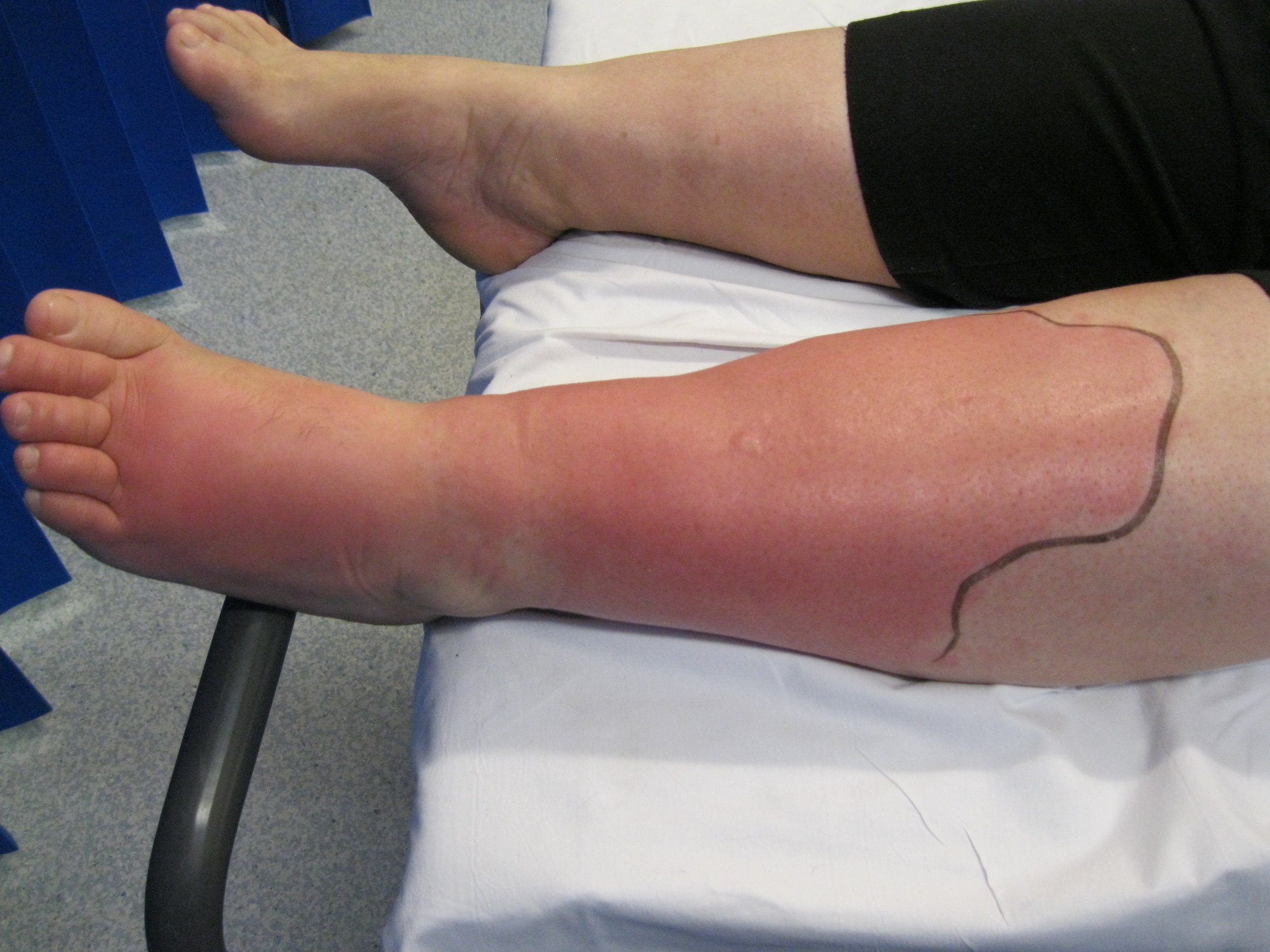Living with lymphedema increases your risk of developing cellulitis, a serious skin infection that requires medical attention. When cellulitis develops, your skin may become red, warm, and tender to the touch, often accompanied by fever and fatigue.
Here’s everything you need to know about the cellulitis-lymphedema link so you can lower your chances of getting the infection and recognize early symptoms.
Seeking immediate medical care helps prevent complications and supports better management of both conditions.
What Is Lymphedema?
Lymphedema develops when extra lymph fluid builds up in body tissues. This happens because of a compromised lymphatic system. This condition typically affects the arms or legs, causing swelling, tightness, and decreased range of motion.
There are two types of lymphedema.
- Primary lymphedema is a rare condition that people are born with, caused by problems with how the lymphatic system developed.
- Secondary lymphedema is much more common – it develops when there’s damage to your lymphatic system, often from cancer treatments like lymph node removal surgery or radiation therapy.
When the lymphatic system becomes damaged or doesn’t function properly, fluid accumulates in the affected area, leading to swelling.
Lymphedema is a chronic condition, but management practices like physical therapy can help you live a fulfilling and active life.
Learn how to prevent lymphedema and reduce your risk.
What Is Cellulitis?
Cellulitis is a bacterial skin infection that causes redness, warmth, and swelling in the affected area.
It develops when bacteria enter through breaks in the skin, such as cuts, scrapes, or areas of dry, flaky skin. The infection most often develops in your lower legs, accounting for 75-90%1 of all cases.
Untreated cellulitis spreads quickly, so it’s very important to seek medical attention right away if you suspect you might have the infection.
Lymphedema vs Cellulitis
Lymphedema and cellulitis can both cause swelling, but they’re different conditions that need different treatments.
With lymphedema, the swelling is chronic. It also develops slowly over time. You might notice the swelling gets better when you raise the affected limb.
Wearing special compression garments and doing other forms of lymphedema self-care often helps manage the condition. Although unpleasant, lymphedema isn’t life-threatening.
Cellulitis is an acute bacterial infection.
The swelling appears quickly and comes with redness and warmth in the affected area. You’ll likely feel sick and might have a fever. Cellulitis requires immediate antibiotic treatment. Left untreated, it can have serious consequences.
Lymphedema and Cellulitis: Is There a Link?
Cellulitis is unfortunately a common complication of lymphedema. Research shows that 37.6% of people living with lymphedema had experienced at least one episode and 23.3% had recurrent cellulitis.
When you have lymphedema, your lymphatic system is already compromised, making it harder for your body to fight off infections. This weakness makes you more likely to develop cellulitis.
When cellulitis occurs, it can further damage your lymphatic system, which may worsen your lymphedema.
However, having lymphedema doesn’t mean you’ll definitely get cellulitis.
With proper education about symptoms and good self-care habits, you can manage lymphedema and live a full, active, and infection-free life.
Learn more about lymphedema treatment.
What Causes Cellulitis?
Cellulitis develops when bacteria enter your body through breaks in your skin. These openings don’t need to be large – even tiny cracks, scratches, or dry patches can let bacteria in.
When you have lymphedema, these small breaks become more likely to trigger an infection because your body’s natural defense system isn’t working at full strength.
Sometimes the exact cause of cellulitis is unknown.
Symptoms of Cellulitis Infection
Recognizing cellulitis early makes it easier to help your immune system to fight infection. Watch out for these common signs:
- Redness that spreads or expands over hours or days
- Swelling that feels warm and tender when touched
- Skin that looks stretched, shiny, or glossy
- Areas that feel harder than the surrounding skin
- Possible blisters or dark marks on the skin
- Fever
- Chills and sweating
- Fatigue or unusual tiredness
- A general feeling of being unwell
- Muscle aches and joint stiffness
- Red streaks extending outward from the affected area
- Swollen lymph nodes near the infection site
- Increased pain or tenderness
- Skin that feels notably warmer than surrounding areas
If you have lymphedema and notice any of these symptoms, especially skin changes or fever, contact your healthcare provider immediately. Quick action helps prevent the infection from spreading and reduces the risk of complications.
Cellulitis symptoms can develop rapidly, sometimes within hours, so don’t delay seeking medical care if you’re concerned.
Lymphedema Cellulitis Photos
In these photos, we can see how cellulitis presents in someone who has lymphedema.
You can see that one part of the leg is redder than the rest. There’s a dark line drawn on the leg to show exactly where the infection stops. This clear line between red and normal skin is typical of cellulitis.
There’s also noticeable swelling.

These photos show an obvious case of cellulitis, but the signs might be harder to spot when an infection is just starting.
If you notice your skin becoming red or feeling warm, especially if it happens quickly, get in touch with your doctor right away.
Cellulitis Lymphedema Treatment
Your doctor will prescribe antibiotics to treat cellulitis. You’ll typically get oral antibiotics to take at home, but if the infection is severe, you might need to get them through an IV in the hospital.
During treatment, your doctor will watch how your infection responds to the antibiotics. They’ll check if the redness and swelling are getting better and make sure the infection isn’t spreading. Make sure to complete the full course of your antibiotics even if your symptoms get better.
How to Lower Your Risk of Developing Cellulitis
Good skin care is the best way to lower your risk of developing cellulitis. Here’s what you can do:
- Keep your skin clean and moisturized every day
- Always wash cuts or scrapes with soap and water, even tiny ones
- Use antibiotic cream on any cuts and cover them with clean bandages
- Check your skin daily for cuts, scrapes, bug bites, open wounds, or signs of infection
- Avoid walking barefoot, especially outdoors
- Trim nails carefully to avoid cutting your skin
- Wear gloves when gardening or doing work that might hurt your skin
- Protect your skin from sunburn
- Keep your compression stockings and garments clean
- Replace compression garments when they start to wear out
- Don’t remove cuticles or do aggressive manicures/pedicures
- Keep pets’ nails trimmed to avoid scratches
- Use insect repellent to prevent bug bites
Overall, do your best to keep your skin as healthy and protected as possible.
Living with Lymphedema
Lymphedema is a chronic condition, but it doesn’t mean that you have to accept swelling, discomfort, and infections like cellulitis as your new normal. There are things you can do to minimize your symptoms and maximize your life.
Here are the key ways to manage lymphedema:
- Physical Therapy: There are special exercises that help move excess fluid through your body and reduce swelling. These exercises, when done consistently, help maintain good circulation and manage symptoms. Try this Full Body Lymphedema Exercise Routine.
- Compression Therapy: Wearing compression garments helps prevent fluid buildup in your affected limb. These special garments provide gentle pressure that encourages fluid movement and helps control swelling throughout the day. Here are my favorite lymphedema products.
- Manual Lymphatic Drainage (MLD): This gentle massage technique helps move fluid out of swollen areas and into working lymph vessels. Your therapist can perform MLD and teach you self-massage techniques to do at home.
- Skin Care: Good skin care helps prevent infections like cellulitis. Keep your skin clean and moisturized, protect it from cuts and scrapes, and check it for any changes or signs of infection.
- Healthy Habits: Staying at a healthy weight helps reduce stress on your lymphatic system. Regular exercise, like walking or swimming, also helps move fluid through your body. You should also stay hydrated and eat a balanced diet to support your overall health!
Managing lymphedema is a daily practice, but it gets easier with time. As you learn what works best for you, the care routine becomes a natural part of your day.
Many people with lymphedema continue to work, exercise, travel, and enjoy their favorite activities.
Unfortunately, it can often be challenging to get education and support about living with lymphedema.
As a Certified Lymphedema Therapist, I often see people who develop lymphedema after cancer treatment and don’t receive enough information about how to manage it.
This is why I created Lower Body Lymphedema Rehab.
It’s an online program that teaches you physical therapy exercises and self-care practices that you can integrate into your daily routine to control swelling, reduce the risk of cellulitis, and improve your quality of life.

FAQs
Can cellulitis cause lymphedema?
Yes, repeated episodes of cellulitis can damage your lymphatic system and lead to lymphedema. Each time you get cellulitis, the infection causes inflammation that can harm the lymph vessels and nodes in the affected area. Over time, this damage makes it harder for your body to drain fluid properly, which can cause lymphedema to develop or make existing lymphedema worse.
Can lymphedema cause cellulitis?
Lymphedema doesn’t directly cause cellulitis, but it’s a common complication that many people experience. Your lymphatic system helps your body fight infections, but when you have lymphedema, this system isn’t working as well as it should. This means your body’s natural defenses are weaker, which can make you more vulnerable to cellulitis. Bacteria also thrive in swollen tissue.
You’re most likely to develop cellulitis in your legs, but it’s also a less-known side effect of breast cancer treatment and other cancer surgery.
How can you tell the difference between cellulitis and lymphedema?
Lymphedema is a chronic condition and cellulitis is an acute bacterial skin infection that requires immediate treatment with oral or intravenous antibiotics. Lymphedema develops slowly over time, and it doesn’t make you feel sick. Cellulitis appears suddenly, usually within hours or days, and causes redness, warmth, and tenderness. You’ll often have flu-like symptoms and have a fever.
How do you treat cellulitis in lymphedema?
Treatment for cellulitis requires antibiotics to stop the infection from spreading. Your doctor might give you oral antibiotics to take at home, or if the infection is severe, you might need IV antibiotics in the hospital. You may also need to make changes to your regular lymphedema self-care routine while you’re healing from the infection.
What does lymphedema infection look like?
Cellulitis is an acute bacterial infection that often develops when you have lymphedema. When infected, skin becomes redder than usual, feels warmer to touch, and may be tender or painful. You might notice a clear line between the infected and healthy skin. The area might look shiny or stretched, and you might see red streaks spreading from the infected area. These changes usually happen quickly, not like the gradual swelling of lymphedema. You might also start running a fever.
What is the life expectancy of a person with lymphedema?
Having lymphedema doesn’t shorten your life expectancy. It’s a chronic condition that needs ongoing management, but most people with lymphedema live normal lifespans. Proper care and management of your symptoms, including physical therapy exercises and skin care to prevent infections like cellulitis, allow people with lymphedema to lead full, active lives.
Is cellulitis and lymphedema a vicious cycle?
Cellulitis and lymphedema can create a challenging cycle. Lymphedema makes you more likely to get cellulitis, and when you get cellulitis, it can damage your lymphatic system and make your lymphedema worse. But proper treatment is key. There are steps you can take to minimize lymphedema swelling and lower your risk of infection. Learn more in Lower Body Lymphedema Rehab.
When is lymphedema an emergency?
Lymphedema is rarely an emergency on its own, but you need to see a doctor immediately if you develop cellulitis, an acute bacterial infection. Watch for sudden changes like increasing redness, unusual warmth, or growing pain in the affected area. You may also develop a fever, chills, or feel generally unwell along with these skin changes. Cellulitis can develop quickly and needs treatment with antibiotics to prevent serious complications.
What does the beginning of cellulitis look like?
Early cellulitis often starts as a patch of skin that becomes redder, warmer, and more tender than the surrounding area. You might notice this change happening quickly, over just a few hours. The redness may spread or expand, and the skin might feel slightly swollen or tight. You might also develop a fever or feel generally unwell. You should take even these mild symptoms seriously if you have lymphedema.
Get More Support in Lower Body Lymphedema Rehab
Managing lymphedema and practicing good skin care can help prevent cellulitis.
If you want to start or improve your lymphedema self-care routine, you can find more education & physical therapy exercises in Lower Body Lymphedema Rehab!
Article Sources
- Firas Al-Niaimi, Neil Cox. Cellulitis and lymphoedema: a vicious cycle. 14 February 2014 ↩︎











